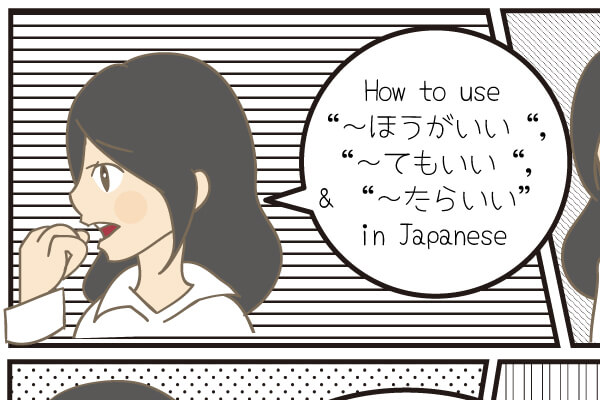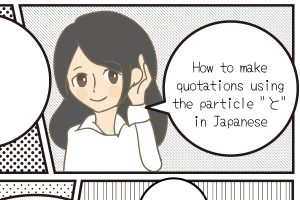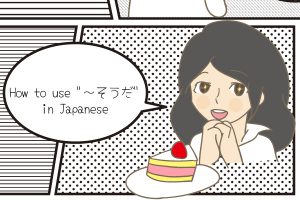How to use “~ほうがいい”, “~てもいい”, & “~たらいい” in Japanese
Last week, Shiho explained how you can express your thoughts and make quotations in Japanese using the particle “と”. Did you get the chance to practice a bit?
In this week’s article we will take a look at Shiho’s video explaining the difference between “~ほうがいい”, “~てもいい”, & “~たらいい” and how to use each expression correctly.
| Table of Contents [About “~ほうがいい”, “~てもいい”, & “~たらいい”] [“~ほうがいい”] [“~てもいい”] [“~たらいい”] |
[About “~ほうがいい”, “~てもいい”, & “~たらいい”]
These expressions will enable you, the speaker, to give advice, warnings or suggestions to your listener, or to give/ask for permission. The meaning and use are a bit different for each expression, but they do have one thing in common: Since it is kind of impolite to give advice, make suggestions or give permissions to your boss or seniors (“Senpai”), you should never use them that way with them. However, asking for permission from a boss or Senpai is completely fine.
Simply remember that you have to take into consideration what your relationship is with the person you’re talking to before using these expressions.
[“~ほうがいい”]
First, let’s take a look at “~ほうがいい”. You construct “~ほうがいい” by using a verb + タ形 (ta-form, past-form) + “~ほうがいい”. You can use this expression to give affirmative advice, suggestions or warnings.
In more detail, “~ほうがいい” expresses that current conditions or actions should not be continued but should be exchanged by another course of action and do the opposite – rest until they feel better.
Example: A is obviously not feeling very well.
So you look at A and say:
具合が悪そうですね。少し休んだ方がいいですよ。
You look ill. You should be getting some rest.
In this case, you would have looked at A and noticed they kept on working despite obviously not feeling very well, so you suggest to stop their current course of action.
Now, you might be wondering why “~ほうがいい” is built with the “タ形”, the past form of the verb. This is because the ta-form is not only used for expressing the past. It can also be used to express current conditions while simultaneously conveying the feelings of the speaker.
Therefore, if you use “~ほうがいい” without the ta-form, it stops being a suggestion or advice (conveying the speakers feelings), and can be used to simply compare two options in a more general statement.
Example:
A: 今休むのと、後で休むのとどちらがいいですか?
A: Taking a rest now or taking a rest later, which one is better?
B: 今休むほうがいいです。
B: Resting now is better.
Now, if you want to use “~ほうがいい” with a negative verb, you do not use it in the past form, but you simply use the present negative form “~ないほうがいい”.
Example:
お菓子はあまり食べないほうがいい。
You shouldn’t eat too many sweets.
[“~てもいい”]
Next, let’s take a closer look at “~てもいい”. “~てもいい” is constructed by using a verb + テ形 (te-form) + “~てもいい” and signifies giving or receiving permission to do something. This expression can be used to give permission to others or yourself.
Example:
A: 入ってもいいですか?
A: Can I come in?
B: はい、どうぞ。
B: Yes, please come in.
The above example is an example where the speaker addresses another person. Permission granted to yourself could look like this:
ダイエット中だけど、誕生日パーティーだから、たくさんケーキを食べてもいいよね!
I’m on a diet, but it’s a birthday party, so I suppose it’s okay to eat lots of cake!
To use “~てもいい” in its negative form, you use the negative form of the テ形 + もいい. In this form, “~なくてもいい” signifies that something (e.g. an action) is not necessary.
Example:
今度の金曜日は仕事に行かなくてもいいから嬉しい。
I’m happy because I don’t have to go to work next Friday.
[“~たらいい”]
Lastly we will explain about “~たらいい”. While “~ほうがいい” is more along the lines of advice or even a warning, “~たらいい” conveys more of a suggestion or recommendation. With “~ほうがいい”, the speaker notices a situation they think cannot continue. With “~たらいい”, the speaker merely states what they are thinking without a strong opinion on the current situation.
Therefore, “~たらいい” can come across as a little cold. If you want to make a suggestion that sounds a bit more friendly, you can use “~といい” instead.
Example:
具合が悪そうですね。少し休んだらいいですよ。
You look ill. Why don’t you take a rest?
具合が悪そうですね。少し休むといいですよ。
You look ill. It might be better if you took a rest.
To a Japanese speaker, the second option sounds a lot more kind and friendly.
For both “~たらいい” and “~といい” there is no negative form.
We know all of these expression seem fairly similar, especially when translated to English, so keep practicing them until you notice the small differences in Japanese!
As always, don’t forget to check out the video on this class and tune in to our livestream every wednesday at 6pm (JST) for the real deal!
| 意味 | Meaning |
| 使い方 | Way to use something |
| 使い分ける | To use properly, to distinguish |
| 助言 | Advice, suggestion |
| 忠告 | Advice, warning |
| 許可 | Permission |
| 勧め | Recommendation |
| 共通 | Commonness, shared point |
| 先輩 | Senior (at work or school) |
| 上司 | Boss |
| 肯定的な | Affirmative |
| 逆 | Opposite |
| 選択肢 | Choices |
| 比べる | To compare |




